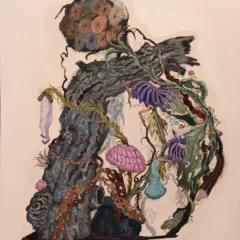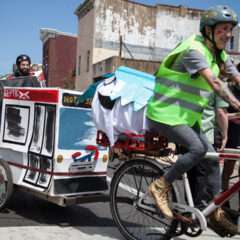We received this post from Andrea Kirsh

Parade of Bootblacks, Protest March of Shoeshine Men, Artist/Maker: Alfredo Zalce, Mexican, 1908 – 2003, Published by Taller de Gráfica Popular, Mexico City, 1940, Made in Mexico, Color lithograph, 13 5/8 x 18 1/8 inches (34.6 x 46 cm) Sheet: 18 1/2 x 26 3/8 inches (47 x 67 cm)
Mexican art in the 20th century is inextricably linked with politics; after the Revolution of 1920, Mexican artists, striving to forge a local tradition distinct from European sources ( a nationalist movement known as Mexicanidad) worked to create art for a broad segment of society, including an illiterate peasantry. Rejecting the bourgeois tradition of easel painting, they produced murals that would bring them international fame (and on the basis of which Orozco, Rivera and Siqueros all traveled to the United States where the first two produced commissioned murals and Siqueros found significant influence as a teacher). The flip side of their mural-making was their printmaking.
These can be divided into two distinct groups: prints cheaply-made for political or didactic purposes to be distributed as flyers, posters, illustrations in various Communist Party broadsheets and the like, and those made for collectors. The prints for collectors sometimes reproduced images from the artists’ murals and often reflected pointed political commentary. Many of their collectors, in Mexico and abroad, were sympathetic, if not entirely committed, to the same political and social ideals. This is reflected by the most luxuriously-produced print in the exhibition, Alfredo Zalce’s extraordinary four-color lithograph of Protest March of Shoeshine Men.
Mexico and Modern Printmaking at the Philadelphia Museum of Art through Jan. 14, 2007 presents 125 prints, mostly from the collection of the PMA and the San Antonio Museum of Art.
The exhibition begins with a brief background to the post-Revolutionary art; it includes one pre-WWI broadside, published by Vanegas Arroyo and illustrated by an unknown contemporary of Posada. The lack of Posada’s own work is hard to understand, since he did for calaveras (skeletons, prominent in Day-of-the-Dead celebrations) what Durer did for the horsemen of the Apocalypse, and Mexico’s post-revolutionary artists all looked to him as their progenitor. Posada’s spirit hovers over the exhibition, and he is specifically honored in Leopoldo Mendez’ grave linocut portrait, Posada in his Workshop (Homage to Posada) (1953).

Jose Guadeloupe Posada, and example of two of his calaveras
Nearby are Jose Clemente Orozco’s early prints, made not in Mexico, but during his period in the U.S.; produced as a way to finance his living expenses. The most memorable is the gruesome Lynching (1934): four lynched figures being consumed by flames. It was part of an artists’ cooperative project by the Contemporary Print Group, which preceded the influential Mexican Taller de Grafica Popular. The Lynching had an interesting history, included in exhibitions by both the NAACP and the John Reed Club. Further down the wall are the bitter suite of lithographs Orozco made upon returning to Mexico, full of his disappointment at post-revolutionary conditions: wretched peasantry, escapist alcohol abuse, prostitution, pandering to tourists, and political tendency towards demagoguery.

The Lynching, Plate 6 from The American Scene, No. 1, album of six lithographs, Artist/Maker: José Clemente Orozco, Mexican, 1883 – 1949, Printed by George Charles Miller, American, 1894 – 1965, Published by Contemporary Print Club, 1934, Made in United States, Lithograph, Image: 12 3/4 x 9 inches (32.4 x 22.9 cm) Sheet: 15 15/16 x 11 7/16 inches (40.5 x 29.1 cm)
The exhibition’s last room contains the products of the Taller de Grafica Popular, an activist artists’ collective that achieved an international reputation. The Taller printed work for major artists outside its membership, such as Siqueros and Carlos Merida, and attracted visiting artists from the U.S. and South America. In addition to individual prints, the workshop produced large numbers of posters, pamphlets and flyers advocating against Fascism, on behalf of workers’ rights, literacy, and other matters of social justice. The exhibition gives a good idea of the range of the TGP’s activities.

Fascism. 8th Lecture. How to Combat Fascism, Artist/Maker: Jesús Escobedo, Mexican, 1918 – 1978, Published by Taller de Gráfica Popular, Mexico City, 1939, Lithograph (poster)
First cell phone audio tour
John Ittman, the curator, has provided an excellent introduction to 11 of the prints via a free cell phone audio tour; this is a first for the PMA (and for me), and a unique occasion where the museum welcomes visitors to use cell-phones in the galleries. In fact Ittman’s tour gives a clearer context for the work than do the wall labels, and his contributions to the exhibition catalogue – lavish and fully illustrated– provide a nuanced view of how printmaking fit into the artistic, economic and political lives of these artists.
Ittman’s brief selection differs significantly from the ones I discussed here, since many of the prints that interested me the most are those produced as ephemera, and infrequently exhibited.
The standard museum presentation of uniform matting and frames tends to downplay their origin as cheap paper pamphlets, signs, and posters which were handled, read, tacked to walls, then ultimately discarded. This is clearly-illustrated by one of the most striking images in the exhibition, Leopoldo Mendez’s haunting Proletarian Hand (1932), the boney fingers composed, on close inspection, of hanged bodies. The catalog illustration (p. 60) reveals what the mat obscures: blank paper for text at the top and side of the image (this is an incomplete proof), and further text on the back of what was a flyer.

Leopoldo Méndez, The Popular Party is the Youth Party, 1948 poster; Pablo O’Higgins, May Day, 1947, poster; photograph: Putting up posters of the T.G.P., 1948. Source: Graphic Witness, a wonderful resource for historical and contemporary political graphics; other sources for more Latin American material are here and here.
Both the exhibition and catalogue could have used a few archival photographs of this material in its original use, tacked to walls and lampposts or being distributed at meetings and rallies; this would have emphasized the continuity of much Mexican printmaking with American posters and underground comics of the 1960s and the recent political graphics of artists such as Art Spiegelman and Sue Coe.
This fascinating exhibition is a heady reminder of the possibilities of art in the service of social change. This spirit may seem a bit battered these days, where so much of our imagery is commercially-generated, but the web has offered new means for unlimited alternative visions, and artists in Philadelphia are still producing printed material in the same spirit (two examples being Dan Murphy and Anthony Smyrski’s free tabloid, Megawords, and the agitprop graphics of Eric Joselyn (see my article here on Joselyn) currently on view in the exhibition What you got to say? at the Philadelphia Folklore Project.
Mexico and Modern Printmaking is at the PMA through Jan. 14, 2007, and then travels to Nashville, Phoenix and San Antonio.
–Andrea Kirsh is an art historian living in Philadelphia. See her Philadelphia Introductions essays on emerging artists at inliquid. 















